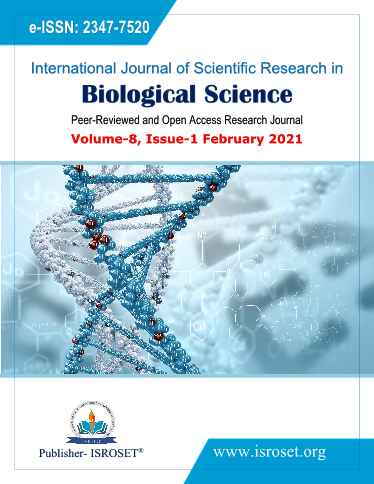Bioremediation Potential of Mushrooms
Keywords:
Bioremediation, Mushroom, fungiAbstract
Potential of Mushroom to work as Bio-remediating agent has made a significant remark in the field of Environment Management. Ability of mushrooms to grow on agro-industrial waste has made researchers to ponder over the new and better possibilities to clean the environment. There are certain things which are yet to be explored like oil is a mixture of a number of toxic derivatives. Can mushrooms eradicate or detoxify all of them? Secondly, Can the edible species of mushroom involved in bioremediation, be declared safe to use? Restoration of polluted land can be used to grow food crops or not? So, there is a lot to explore yet. Although, this practice has a lot of future prospects, carrying forward the economic concept of Mushroom Cultivation Technique & its role in Bioremediation.
References
O.M. Adedokun and A.E. Ataga, “Effects of Crude Oil and Oil Products on Growth of Some Edible Mushrooms”. Journal of Applied Sciences & Environmental Management, Vol 10 No. 2 pp. 91-93, 2005.
C. O. Adenipekun and R Lawal, “Uses of mushrooms in bioremediation”: A review. Biotechnology and Molecular Biology Review, Vol. 7 No.3 pp 62-68, 2012.
F.N. Emuh, “Mushroom as a purifier of Crude oil polluted soil”. International Journal of Science & Nature, Vol. 1 No. 2 pp.127-132, 2010.
D. Beyer, (2005) “Spent mushroom substrate (SMS) research in the US”. AMGA J. Summer Issue 31-32, 2005.
J. A. Buswell, Y. J. Cai and S. T. Chang, “Ligninolytic enzyme production and secretion in edible mushroom fungi”. In Mushroom Biology and Mushroom Production, D. J. Royse ed., University Park, Pan. 113-122, 1996.
J. A. Buswell, Y. J. Cai, S. T. Chang, J. F. Peabody, S. Y. Fu and H. S. Yu., “Lignocellyulolytic enzyme profiles of edible mushroom fungi". World Journal Microbiology & Biotechnology, Vol.12 pp. 537-542, 1996.
S. T. Chang, “Mushroom cultivation using the “ZERI” principle: potential for application” Brazil. Micol. Apl. Int., Vol.19 pp. 33-34,2007.
S. T. Chang, and J. A. Buswell, “Mushroom nutriceuticals”. World J. Microb. and Biotech. Vol. 12 pp. 473-476, 1996.
S. T. Chang, and J. A. Buswell, “Development of the world mushroom industry: Applied mushroom biology and international mushroom organization”. Intl, J. Med. Mush. (In press), 2008.
S. T. Chang and P. G. Miles, “Introduction to mushroom science”. In Tropical Mushrooms-Biological Nature and Cultivation Methods, S. T. Chang and T. H. Quimio, the Chinese University Press, Hong Kong, pp. 3-10, 1982.
T.R. Dhiman, Zaman M.S.,Gimnez R.R.,Walters J.L.,Treacher R. “Biotechnological applications & potential of wood degrading mushrooms of genus Pleurotus”. Applied Microbiology &b Biotechnology Vol. 58 pp. 582-594, 2002.
J. A. Buswell and S. T. Chang, “Biomass and extracellular hydrolytic enzyme production by six mushroom species grown on soybean waste”. Biotechnology Letters, Vol. 16 pp. 1317-1322, 1994.
J. A. Buswell, Y. J. Cai and S. T. Chang, “Effect of nutrient nitrogen and manganese on manganese peroxidase and laccase production by Lentinula edodes”. FEMS Microbiology Letters Vol. 128 pp. 81-88, 1995.
P. Stamets, “Mycelium Running: How Mushroom Can Help Save the World”.Published by Ten Speed Press, Berkeley and Toronto, pp. 574, 2005.
P. G. Miles and S. T. Chang, “Mushroom Biology: Concise Basics and Current Developments”. World Scientific. Singapore, pp. 194,1997.
C.A. Reddy, and Z. Matthew, “Bioremediation Potential of White-Rot Fungi”. In: Fungi in Bioremediation. Gadd, G.M. (Ed.). Cambridge University Press, Cambridge, UK, 2001.
H. Singh, “Mycoremediation: Fungal Bioremediation”. Wiley Interscience, 2006.
J. W. Bennett and L. L. Lasure, “More Gene Manipulations in Fungi”. Academic Press, INC. New York, USA, 1991.
P. Stamets, “Growing Gourmet and Medicinal Mushrooms”. Ten Speed Press, Berkeley and Toronto, pp. 339, 2000.
R. B. Beelman and D. J. Royse, “Selenium enrichment of Pleurotus cornucopiae (Paulet) Rolland and Grifola frondosa (Dicks.:Fr.)” S. F. Gray mushrooms. Intl. J. Med. Mushr. Vol. 8 pp.77-84, 2006.
S. Kulshreshta, N. Mathur, P. Bhatnagar and B.L. Jain, “Bioremediation of industrial waste through mushroom cultivation”. Journal of Environmental Biology, Vol.31 pp.441-444, 2010.
H. Harms, D. Schlosser and Y.W. Lukas, “Untapped potential: exploiting fungi in bioremediation of hazardous chemicals”. Nature Reviews Microbiology Vol. 9 pp. 177-192, 2011.
S. Hamman,“Bioremediation capabilities of white- rot fungi”.Biodegradation Vol. 52 pp.1-5, 2004.
R. Cohen, L. Persky and Y. Hadar, “Biotechnological applications and potential of wood-degrading mushrooms of the genus, Pleurotus. Applied Microbiology and Biotechnology, Vol. 58 No. 5 pp. 582–594, 2002.
A. K. Pandey, S. Rajan, S. Sarsaiya and S. K. Jain Mushroom for the National Circular Economy, International Journal of Scientific Research in Biological Sciences, Vol.7, Issue.6, pp.61-69, December, 2020.
Downloads
Published
How to Cite
Issue
Section
License

This work is licensed under a Creative Commons Attribution 4.0 International License.
Authors contributing to this journal agree to publish their articles under the Creative Commons Attribution 4.0 International License, allowing third parties to share their work (copy, distribute, transmit) and to adapt it, under the condition that the authors are given credit and that in the event of reuse or distribution, the terms of this license are made clear.







